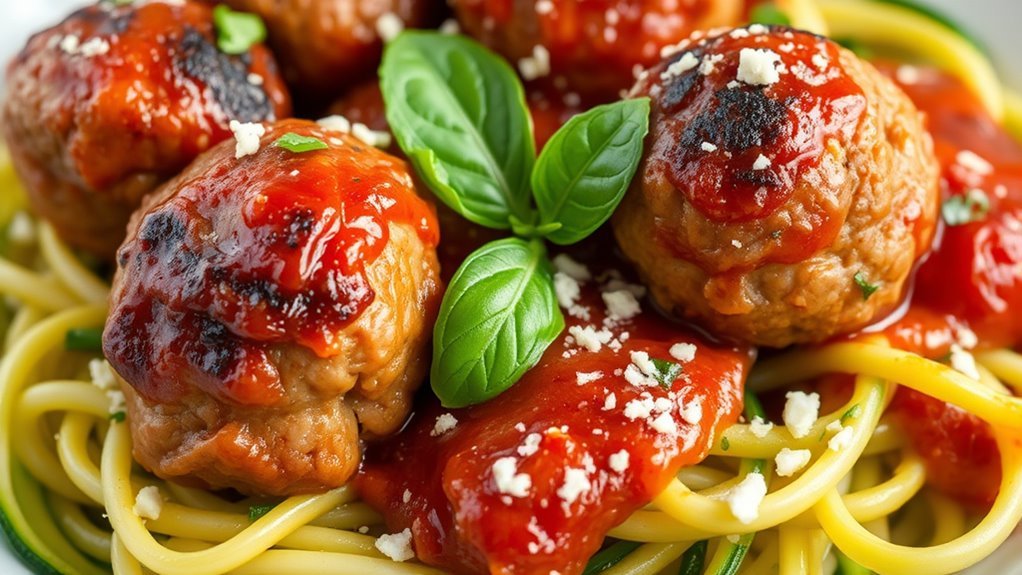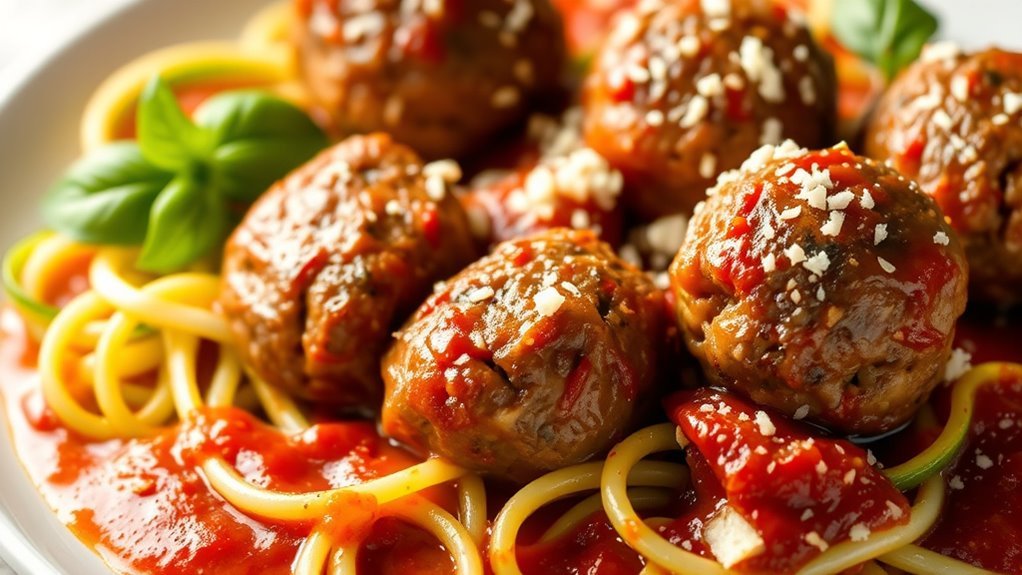Meatballs can definitely fit into a keto diet, but it’s important to choose the right ingredients. Traditional meatballs often contain breadcrumbs, which are high in carbs. Instead, opt for low-carb alternatives like almond flour, crushed pork rinds, or grated cheese for binding. Use fattier cuts of meat for added flavor and satiety. By making these adjustments, you can enjoy delicious meatballs without the carbs. Curious about how to create your own keto meatball recipes? There’s more to explore!
Understanding the Carb Content in Traditional Meatballs

When it comes to enjoying traditional meatballs, have you ever wondered how their carb content stacks up? Typically, meatballs are made with ground meat, breadcrumbs, and various seasonings. The breadcrumbs serve as a primary carb source, contributing notably to the overall carb count. Depending on the meatball variations, such as those made with added fillers or sauces, the carb content can vary widely. For instance, a classic Italian meatball may have around 8-10 grams of carbs per serving, while a recipe heavy on breadcrumbs can push that number higher. If you’re mindful of your carb intake, it’s crucial to reflect on these factors and choose meatball variations that align with your dietary goals while still satisfying your cravings for this delicious dish. Incorporating low-carb options like almond flour or grated cheese can significantly reduce the carbohydrate count.
Keto-Friendly Ingredients to Use

To create keto-friendly meatballs, it’s important to swap out traditional high-carb ingredients for low-carb alternatives. Instead of breadcrumbs, consider using keto substitutes like almond flour or crushed pork rinds, which provide texture without the carbs. For fillers, zucchini or spinach are excellent low-carb fillers that add moisture and nutrients without spiking blood sugar levels. You can also incorporate grated cheese for a cheesy flavor and added fat. When choosing meats, fattier cuts like ground beef or pork maintain flavor and satiety, helping you stay within your keto goals. Always check labels to verify there are no hidden sugars in your seasonings or sauces. With these swaps, you can enjoy delicious meatballs while staying true to your keto lifestyle. Additionally, incorporating ingredients like high fiber content can enhance overall satiety and digestive health.
How to Make Delicious Keto Meatballs

Creating delicious keto meatballs can be a straightforward yet rewarding process, especially when you focus on the right combination of ingredients. Start with ground meat or meat substitutes like turkey or plant-based options to keep carbs low. Incorporate almond flour or crushed pork rinds for binding while maintaining keto-friendly levels. Don’t forget to add a mix of herb seasonings—think garlic powder, oregano, and basil—to enhance flavor without adding carbs. You can also include grated cheese for richness. Shape your mixture into balls and bake or pan-fry until golden brown. By experimenting with different herbs and meat substitutes, you’ll discover a recipe that satisfies your cravings while staying within your dietary goals. Enjoy your culinary freedom! Additionally, using ingredients like healthy fats and oils can further enhance the flavor and nutritional profile of your meatballs.
Creative Ways to Serve Meatballs on a Keto Diet
Meatballs can be a versatile addition to your keto meal plan, providing not just flavor but also creative presentation options. Here are some serving suggestions to elevate your meatball variations:
- Zucchini Noodles: Serve your meatballs over spiralized zucchini for a low-carb pasta alternative, topped with marinara sauce and grated Parmesan.
- Stuffed Peppers: Hollow out bell peppers, fill them with meatballs and cheese, then bake for a colorful, nutrient-rich dish.
- Meatball Skewers: Thread meatballs onto skewers with veggies like cherry tomatoes and bell peppers for a fun, easy-to-eat option at gatherings.
These presentations not only keep your meals interesting but also align with your keto lifestyle, allowing you to indulge without breaking your dietary goals. Incorporating low-carb vegetables into your meals enhances nutrient intake while maintaining ketosis.
Tips for Storing and Reheating Keto Meatballs
After enjoying those creative meatball presentations, you might wonder how to store and reheat them properly for later meals. For ideal meatball storage, let them cool completely before placing them in an airtight container. They can last in the fridge for up to four days or be frozen for up to three months. When you’re ready to enjoy them again, use reheating techniques that preserve flavor and texture. The oven is a great option; preheat it to 350°F and heat the meatballs for about 15-20 minutes. Alternatively, you can reheat them in a skillet over medium heat, adding a splash of broth for moisture. Incorporating healthy fats in your meals can also enhance the overall flavor profile of your meatballs. With these tips, you’ll guarantee your keto meatballs stay delicious and satisfying!
Frequently Asked Questions
Are Meatballs Gluten-Free if Made With Almond Flour?
Yes, meatballs made with almond flour can be gluten-free. Almond flour’s benefits include being low in carbs and rich in healthy fats, making it a great alternative for those avoiding gluten. When you choose gluten-free ingredients for your meatballs, you’re not only catering to dietary restrictions but also enhancing the flavor and texture. Just confirm that all other ingredients are also gluten-free to maintain that standard. Enjoy your delicious, gluten-free meatballs!
Can I Use Turkey Instead of Beef for Keto Meatballs?
Absolutely, you can use turkey instead of beef for keto meatballs—think of it as swapping out a heavy anchor for a sleek sailboat. Turkey offers a leaner option, providing protein while keeping calories in check. With less fat, it can help you stay within your keto macro goals. Plus, turkey brings its own unique flavor. So, don’t hesitate to explore this delicious alternative while enjoying the benefits of a lighter meat option!
How Can I Tell if Meatballs Are Fully Cooked?
To tell if your meatballs are fully cooked, use a meat thermometer to check their internal temperature; it should reach 165°F (74°C) for poultry or 160°F (71°C) for beef. Additionally, look for visual cues: the meatballs should be browned on the outside, and the juices should run clear when you cut into one. Ensuring proper cooking not only enhances flavor but also keeps your meals safe and enjoyable!
Can I Freeze Cooked Meatballs for Later Use?
Yes, you can freeze cooked meatballs for later use! For ideal meatball storage, let them cool completely before placing them in airtight containers or freezer bags. Use freezing tips like separating them with parchment paper to prevent sticking. They can last up to three months in the freezer. When you’re ready to enjoy them, simply reheat in the oven or microwave. This way, you’ve got a quick meal ready whenever you need it!
What Sauces Are Keto-Friendly for Meatballs?
For your meatballs, you can enjoy several keto-friendly sauces. Low carb sauces like marinara made with no added sugar are great options. You might also love creamy sauces, such as Alfredo or homemade pesto, which are rich in flavor and low in carbs. Just be sure to check the labels or make them from scratch to avoid hidden sugars. These options will keep your meals delicious while staying within your keto lifestyle!


